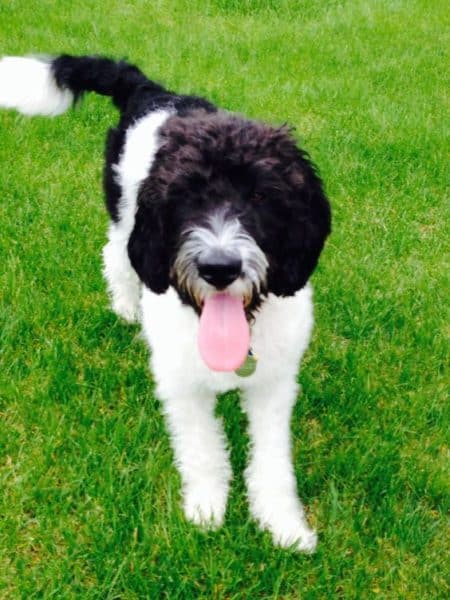Pit Bulls are wonderful pets, however they are protective and require training.
Posted on NextDoor.com in a dog attack thread
While I may have heard this more about Pit Bulls than other types, it really applies to all breeds, with some just more likely than others. And even that varies in different parts of different countries. But, how did this dog ever learn to actually protect people? Or, is it really something else happening?

The Reaction With People
Some dogs are visibly very nervous, and afraid of anything abrupt or unusual. They are often looking back at you, both for reassurance and to make sure they still have a clear path to run over to you.
Often, the dog seems happy and fine walking down the street with you. He may even eagerly greet a few people and even other dogs. Then, a construction machine makes a loud bang. Or, a new person walks over, wearing odd dress or having unusual body language. The dog makes a beeline for the owner and sticks by him for comfort. Except, this time there happens to be another person in the way. While some dogs will just run around, this dog goes into a full panic mode and starts biting to clear his path.
Or, while walking your dog you just greeted a new person. Stepping closer, he slaps your back, or abruptly reaches out to just shake your hand. Your dog seems to go wild and attacks him.
Some of these reaction are only nips, but others can be far more severe. Is this really to protect you?
The Reaction With Dogs
For many reactive dogs, other dogs are just something else to be afraid of. Just one more item in a long list. But a few were socialized with other dogs when young or may have enough interest to override their fears.
But Some Live with Other Dogs
A very common scenario is a shy or somewhat fearful dog who lives with a playful dog. Those two work things out over time, and may become playmates. The more nervous dog may look to the other one for security.
Later visiting a dog park, the playful one may start running and jumping around with other dogs. As the play intensity goes up and the time builds, the nervous one finds she can’t handle it any longer. She wants the other dogs to stop playing so she can calm down, so she confronts them. Often with close barking and other signs, but sometimes a brief attack. Many people will say that she is protecting the other dog, but she’s only trying to calm herself down.
The Dog’s View
The Typical Owner
Even if something seems scary to the dog, he can often see his owner is calm and not concerned at all. We often hear about how good dogs are at reading human body language, so the dog is pretty sure his owner is fine. In which case, the dog has no reason to protect him.
Nor would the dog really know how to protect the owner, other than barking.
And a similar situation happened at the dog park just above. As she knows her playmate very well, there’s no question of the playmate needing help or protection. Instead, the nervous dog simply wants them to stop something she’s not used to, and which is making her more nervous. Given enough time, she would get used to all this, just as she’s become used to her housemate over months. But the park visits are often far too brief for that. And if people decide she’s protecting the other dog, they may not return, or might just yell at her and prevent any learning.
The Nervous Owner
A rescue I worked with was trying a new dog trainer so I went to watch the starting class. She was a basic Clicker Trainer, so most of the dogs (and people) responded as expected. Except for one dog that she had trouble even approaching. The trainer even had her foster stand behind a screen, then slowly approached with treats, and was nearly bitten.
I went over to assess the dog and found this behavior was even more intense near the foster. When I approached the dog, the foster’s body language became more apprehensive, and she was confident the dog would be reactive. I managed to take the dog outside and away for a few minutes, and saw the dog just starting to calm down.
Speaking to the rescue, I suggested this is not a dog for clicker training, and that the best approach might be finding a much calmer foster. They removed the dog from the class but she remained with the foster for several months, where nothing changed. Finally, the rescue moved the dog to a foster who had a bubbly happy temperament. A few weeks later, with no other changes, they told me the dog was no longer protective, and was ready to start learning the world.
The Training Failure
Some time ago, there was a large doodle dog around often who had nipped quite a few people. After a store captured a video, animal control required the owner to provide six months of training and to keep the dog away from people until that training was successfully completed.

I happened to see them at the dog park about six months later. After spending a few minutes with the dog, I told his owner he had learned his “training”, but that the trainer never taught him to handle the anxiety issue that caused the nipping in the first place. He ignored me and said the dog is just naturally protective.
My point was, the dog was not being “protective”. Instead, whenever he was startled by something, he became scared enough to be reactive, and if anybody was then between him and his best security (his owner), he would attack. From what I heard, a few months later a woman leaned over a bench near his owner, and the dog tore into her arm. After a long battle, animal control finally took the dog away from him.
The Rehabilitation Success
While most dog training is tailored to what the owner or trainer feels is necessary, rehabilitation is instead aimed at what the dog actually needs to live safely and happily in his current situation. In the situation here we have two components to handle. First, the dog is becoming anxious, often from some common and non-threatening situations. Second, the only response the dog knows is to immediately seek out his owner.
The First Part – Anxiety
A bit of careful testing will usually show some simple and common scenarios that frighten the dog. Starting from the least reactive scenario, the dog is set up for a controlled repetition to desensitize and reduce his reaction. As the dog calms a bit on one item, we start moving to the more and more difficult cases. In many of them, the most difficult issue is in setting up the controlled scenarios. For dogs scared of skateboards, or statues, or odd dress, you may need occasional help from other people. And a good supply of props can often help.

The more cases you find here, the more likely this dog has additional ones. While you may not get them all, once you handle a good enough sample it will also impact any remaining cases. And for many of these the same solutions will apply. However, those cases involving another dog can be a bit more challenging. To handle that well, you need a few well-trained dogs and access to a variety of others.
A Well Trained Dog?
What’s this well trained dog who helps you like? The simple phrase training usually implies something like a dog trainer’s obedience training. But, things like come, sit, and stay really won’t help here. I’ve seen a few trainers with some very tolerant and laid-back dogs, or dogs who have been trained to ignore everything around them. While that may help to avoid any issues, there’s really nothing for the new dog to learn there.
Instead, a very socially-skilled dog who has experienced and has worked with scared and anxious dogs will know how to respond with little or no direction. They will react to the dog’s interest, but back away when needed to prevent them from becoming too excited and losing control. Something that’s actually very similar to socially-skilled adults who like to teach young pups. Each time the scared dog seems ready, they will encourage (or permit) more activity, slowing it down when needed. The technical term for this is teaching.
The Second Part – Alternative Behaviors

The first part above will never come out perfect, always leaving the very real possibility of an abrupt failure. Some of which may include a bite situation. This part will focus on changing that response. To do so, you need to give some thought to the dog’s behavior here, and how he behaves in other situations where he seems comfortable.
For instance, if she’s upset when her housemate plays with another dog, you must first teach her enough behaviors to be able to guide and manage her reactions.
You then need access, both to her housemate and to a dog the housemate plays with. Fortunately, most scenarios are far simpler, but this is an example of one that may require more time and effort, and repetition may not be very fast. If she does have an interest in meeting and playing with other dogs then some separate socialization lessons are needed. Once she becomes used to the other dog playing with her, the housemate joining in will be less stressful.
But many of these dogs are very slow to make other dogs friends, and some have little interest in doing so. There you have a choice. One way is to simply manage access so that the two dogs when together are never involved with another dog. The other would be in managing the play sessions so that the housemate repeatedly takes breaks from play to allow her to calm down, and your control training is used to maintain a distance.
So, depending on the dog’s interests and control, you might be teaching them how to join in the play, or how to calmly sit and watch from a distance. And some will just walk off and do something else.
The Conclusion
As with any problem, the first step is identifying and understanding the issue. Some dogs seem naturally nervous, while others are not. Some dogs give a variety of signs as they become anxious, while others may say nothing until they are ready to snap. To be both effective and safe, you must answer those questions right at the start.
In the end, the dog has to learn how to feel safe and what he enjoys. Some dogs may then become more independent, while others may continue to need a person or another dog for security. While you can change much of their learned behaviors, the basic temperament will remain.
